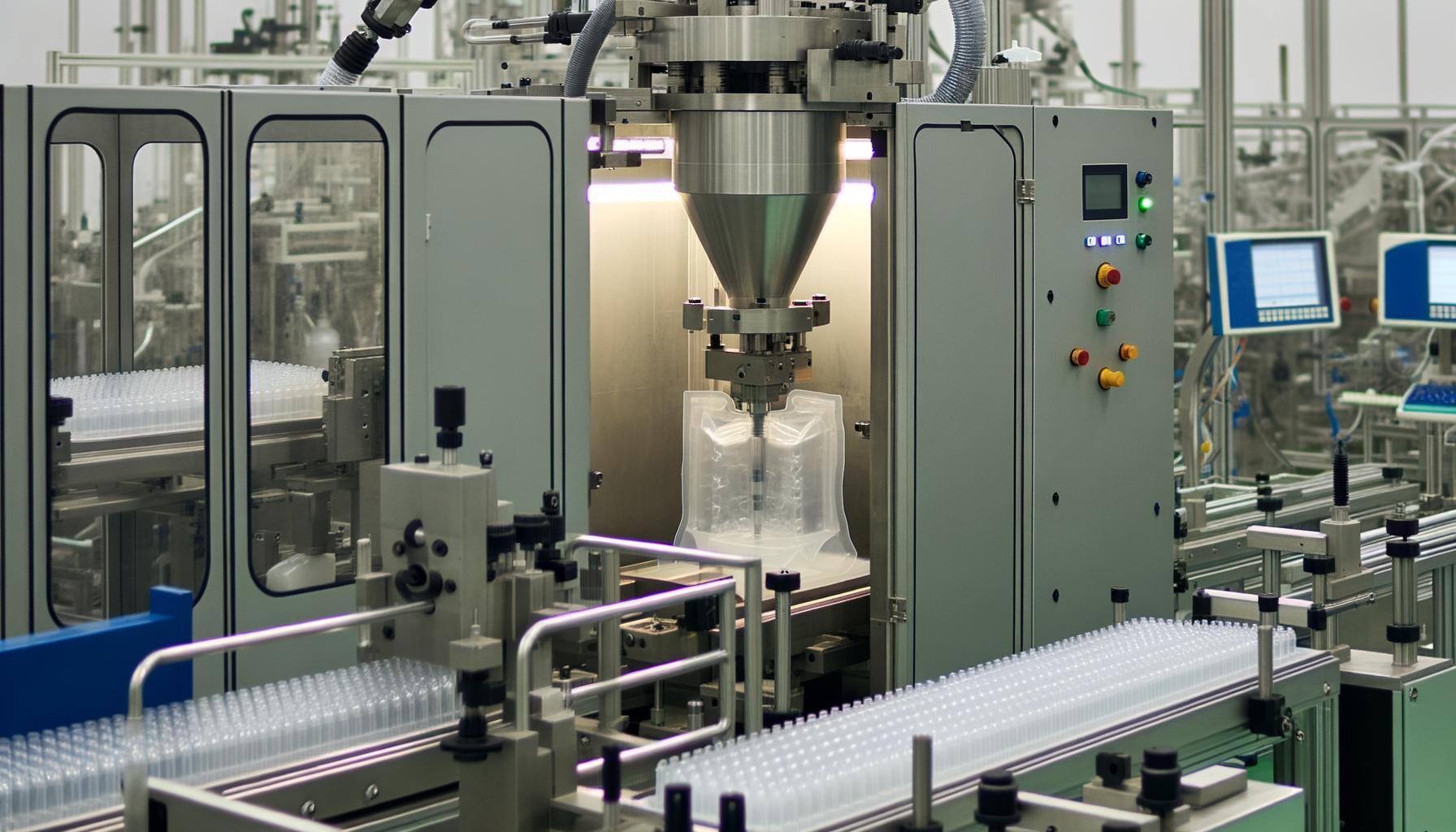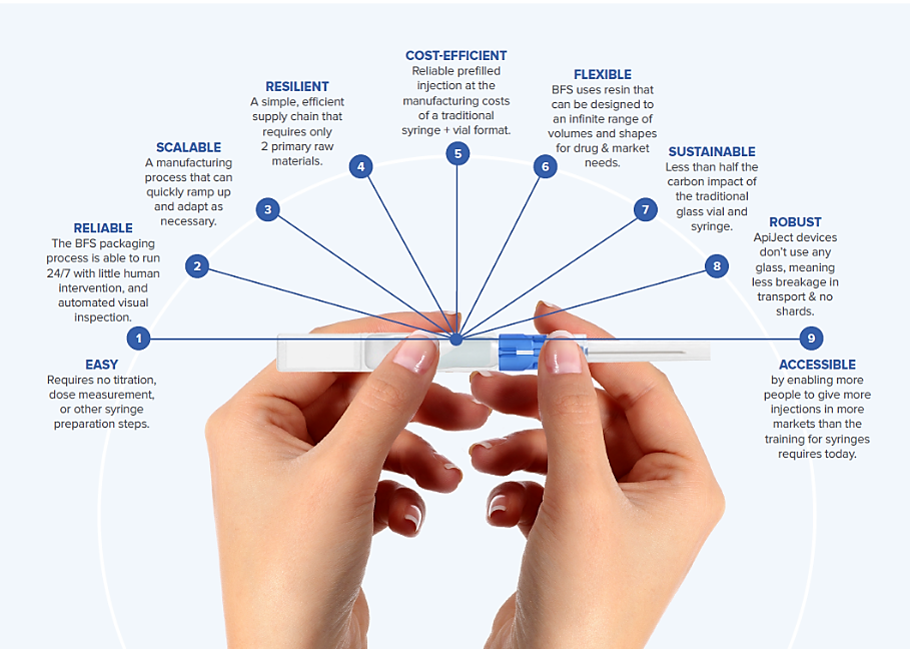How Does Blow-Fill-Seal Work?

Blow-Fill-Seal (BFS) is an industry-recognized advanced aseptic fill-finish process. The BFS process involves a series of steps in the manufacturing of sterile BFS containers for the pharmaceutical industry. The aseptic BFS process is a highly efficient and advanced technology used to produce sterile drug products.
The process begins with heating pharmaceutical-grade resin, and extruding it into a parison, which is then molded into a specific container shape. This container is instantly filled with liquid medication, ensuring the highest level of sterility and product integrity.
Finally, the container is sealed, maintaining the sterility and integrity of the liquid medication inside.
The filling chamber during the BFS process is isolated in an ISO-5 environment, and the efficiency of BFS allows for manufacturing campaigns to be fulfilled with reliable quality regardless of container size or volume. Since BFS uses polymer containers, the respective drug delivery system can be offered in various fill volumes and container shapes, with minimal changeover time.
The entire BFS process, including forming, filling, and sealing, occurs in a single location within an enclosed chamber and is advantageous over glass vials in terms of the filling process, finish process, and packaging.
Key Takeaways
- BFS technology integrates container formation, filling, and sealing in a continuous, automated process.
- It begins with heating and extruding plastic resin to form a parison, which is then molded into the container shape.
- Containers are aseptically filled with the product using a filling mandrel, ensuring sterility.
- After filling, the container tops are immediately sealed, creating a hermetic seal to maintain product integrity.
- The entire BFS process occurs under stringent aseptic conditions, utilizing controlled temperatures for quality assurance.
General BFS Process Overview
The Blow-Fill-Seal technology, an integral process in the pharmaceutical industry, involves a sophisticated sequence of steps: extrusion, molding, filling, sealing, and demolding, all executed under aseptic conditions to guarantee the production of high-quality, sterile containers.
This innovative method guarantees aseptic packaging is achieved efficiently, utilizing controlled temperature conditions throughout the production process. Key to its success, the mold cavity is designed to meet precise specifications, ensuring each BFS container meets high-quality standards.
Additionally, BFS technology offers the flexibility to adapt to varying production volumes, accommodating different sizes of containers with ease. This adaptability ensures the pharmaceutical industry can maintain high-quality standards while meeting the demands for its products, offering confirmation to the freedom and versatility inherent in BFS technology.
Detailed BFS Process Steps
Shifting from a general overview to a more concentrated examination, this section outlines the steps involved in the Blow-Fill-Seal (BFS) process, specifically focusing on the formulation, filling, and sealing of the container, followed by the finishing touches.
Each phase is critical, employing advanced techniques to guarantee sterility, precision, and efficiency in packaging liquids.
Formation of the container
In the Blow-Fill-Seal technology, container formation begins with the heating and extruding of pharmaceutical-grade plastic resin beads to create the foundational parison. This pivotal step guarantees that the containers for sterile drug products start their journey in a state conducive to aseptic filling.
As the parison, a soft yet sturdy precursor to the final plastic containers, descends, it is met by the precision of the BFS machine's mold. This mold encases the parison, shaping it into the destined container form.
This methodical approach to container formation underpins the reliability and sterility of the packaging process, ensuring the safety and efficacy of the products it houses.
Filling of the container
Following the formation of the container through the heating and extruding process, attention shifts to the intricate steps involved in the filling phase of BFS technology. In this aseptic filling process, a filling mandrel equipped with a dosing needle for each container guarantees the sterile product is delivered into the newly formed containers.
Sealing and Finishing
Upon completion of the filling phase, the BFS machine proceeds to the pivotal sealing and finishing steps, where separate seal molds come together to hermetically seal the top of each container. This critical process guarantees that each formed container is not only filled but also securely sealed, safeguarding the contents within.
This sequence safeguards the integrity of the sealed container, achieving a reliable container closure and marking the container's readiness for conveyance and distribution, thereby embodying a sense of freedom in the final product's secure delivery.
Key Takeaways:
- The BFS mold is installed into the BFS machine to form the container shape and size.
- Different machine models require different numbers of BFS molds, ranging from a single mold to a set of up to 20 duplicate molds.
- Production BFS molds are typically made of aluminum bronze and undergo rigorous testing before being used.
- The shape of the BFS mold is crucial as it affects the performance of the container and the ability of the drug product to be successfully filled and survive stability testing.
Top Questions Answered by Experts
What industries primarily use blow-fill-seal technology?
Blow-Fill-Seal technology is utilized in various industries, primarily in pharmaceuticals and healthcare, but also in food and beverage packaging.
The pharmaceutical industry is the primary sector where BFS technology is extensively used. It's employed to produce unit dose containers, such as vials, ampoules, and bottles, for liquid medications, eye drops, nasal sprays, and sterile solutions.
How does BFS compare in cost to traditional packaging methods?
The Blow-Fill-Seal packaging method can be more cost-effective than traditional packaging methods in certain applications. Compared to traditional packaging, BFS offers advantages such as sterility and tamper resistance and often requires less material and labor, leading to potential cost savings.
Are there sustainability benefits to using BFS?
Blow-Fill-Seal is a manufacturing process that can offer sustainability benefits. By reducing packaging waste and energy use, BFS can be a more environmentally friendly option compared to traditional packaging methods.
Can BFS handle high-viscosity products effectively?
BFS technology can effectively handle high-viscosity products. The BFS process allows for the aseptic filling and sealing of viscous liquids, making it a suitable choice for a variety of pharmaceutical and personal care applications.
How does BFS impact product shelf life?
The BFS process helps extend a product's shelf life by creating a sterile, airtight container. The typical packaging components for BFS containers seal the product in a way that prevents contamination and reduces exposure to oxygen, which can degrade the product over time.
What types of plastic materials can be used with BFS?
Materials suitable for BFS technology include a variety of plastic resins such as polyethylene, polypropylene, and ethylene vinyl alcohol. These materials offer flexibility in container design while maintaining the necessary barrier properties to protect the contents from external contaminants.


